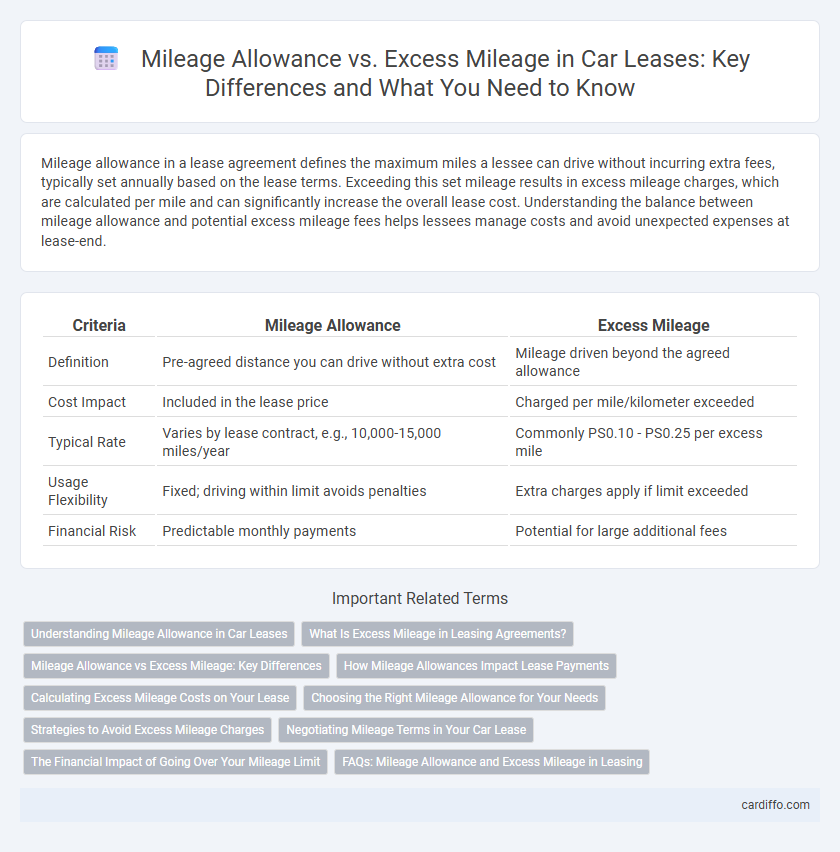Mileage allowance in a lease agreement defines the maximum miles a lessee can drive without incurring extra fees, typically set annually based on the lease terms. Exceeding this set mileage results in excess mileage charges, which are calculated per mile and can significantly increase the overall lease cost. Understanding the balance between mileage allowance and potential excess mileage fees helps lessees manage costs and avoid unexpected expenses at lease-end.
Table of Comparison
| Criteria | Mileage Allowance | Excess Mileage |
|---|---|---|
| Definition | Pre-agreed distance you can drive without extra cost | Mileage driven beyond the agreed allowance |
| Cost Impact | Included in the lease price | Charged per mile/kilometer exceeded |
| Typical Rate | Varies by lease contract, e.g., 10,000-15,000 miles/year | Commonly PS0.10 - PS0.25 per excess mile |
| Usage Flexibility | Fixed; driving within limit avoids penalties | Extra charges apply if limit exceeded |
| Financial Risk | Predictable monthly payments | Potential for large additional fees |
Understanding Mileage Allowance in Car Leases
Mileage allowance in car leases defines the maximum number of miles you can drive annually without incurring extra charges, typically ranging from 10,000 to 15,000 miles per year. Exceeding this limit results in excess mileage fees, often charged at a rate between $0.15 and $0.30 per mile, significantly increasing lease costs. Accurately estimating your annual mileage helps optimize lease terms and avoid unexpected expenses.
What Is Excess Mileage in Leasing Agreements?
Excess mileage in leasing agreements refers to the number of miles driven beyond the contractual mileage allowance specified in the lease. Lease contracts typically include a set mileage limit, and exceeding this limit results in additional charges calculated per extra mile. Understanding excess mileage fees is crucial for managing lease costs and avoiding unexpected expenses at lease-end.
Mileage Allowance vs Excess Mileage: Key Differences
Mileage allowance in a lease agreement specifies the maximum number of miles a lessee can drive without incurring extra charges, typically ranging between 10,000 and 15,000 miles per year. Excess mileage refers to the cost applied for every mile driven beyond the allowed limit, often charged at rates between $0.15 and $0.30 per mile. Understanding mileage allowance versus excess mileage is crucial for managing lease costs and avoiding unexpected fees at lease-end.
How Mileage Allowances Impact Lease Payments
Mileage allowances directly affect lease payments by setting a fixed limit on the number of miles driven annually without penalty, typically between 10,000 and 15,000 miles. Exceeding the mileage allowance triggers excess mileage charges, which average around 15 to 25 cents per mile, increasing the total cost of the lease. Properly estimating mileage needs helps avoid unexpected fees and keeps lease payments predictable and manageable.
Calculating Excess Mileage Costs on Your Lease
Calculating excess mileage costs on your lease requires knowing your annual mileage allowance specified in the contract and comparing it to the actual miles driven. Excess mileage is charged per mile based on the lease agreement, often ranging from $0.15 to $0.30 per mile, which can significantly increase the total lease cost. Monitoring your odometer regularly helps avoid unexpected fees by staying within your mileage allowance.
Choosing the Right Mileage Allowance for Your Needs
Selecting the appropriate mileage allowance in a lease agreement is crucial for managing costs and avoiding excess mileage fees. Exceeding the agreed mileage allowance often results in costly per-mile charges that can significantly increase the total lease expense. Evaluating your typical driving habits and estimating annual mileage accurately helps in choosing a lease plan that balances monthly payments with potential excess mileage costs.
Strategies to Avoid Excess Mileage Charges
Carefully estimating your annual mileage and selecting a lease agreement with a slightly higher mileage allowance can prevent excess mileage charges. Regularly tracking your mileage using apps or odometer readings helps identify if you're approaching the limit, allowing timely adjustments to driving habits. Considering lease-end options such as purchasing additional miles upfront or negotiating mileage terms during lease renewal can also minimize unexpected fees.
Negotiating Mileage Terms in Your Car Lease
Negotiating mileage terms in your car lease is crucial to avoid costly excess mileage fees, which typically range from 10 to 25 cents per mile above the agreed limit. Lease agreements often offer mileage allowances between 10,000 and 15,000 miles per year, so accurately estimating your annual driving habits can save thousands in penalties. Securing a higher mileage allowance upfront or negotiating a lower excess mileage rate provides financial flexibility and protects your budget throughout the lease term.
The Financial Impact of Going Over Your Mileage Limit
Exceeding your lease mileage limit leads to excess mileage charges, which can significantly increase the total cost of your lease agreement. Typical penalties range from $0.15 to $0.30 per mile, potentially adding hundreds or thousands of dollars to your lease expenses. Staying within the mileage allowance helps avoid these costly fees and preserves the vehicle's residual value at lease-end.
FAQs: Mileage Allowance and Excess Mileage in Leasing
Mileage allowance in leasing refers to the predetermined number of miles a lessee can drive annually without incurring extra charges, typically ranging between 10,000 to 15,000 miles per year. Excess mileage occurs when the lessee drives beyond the agreed limit, resulting in additional fees usually charged per mile, often between 10 to 25 cents. Understanding mileage allowance and excess mileage fees is crucial for managing lease costs and avoiding unexpected expenses at lease end.
Mileage Allowance vs Excess Mileage Infographic

 cardiffo.com
cardiffo.com